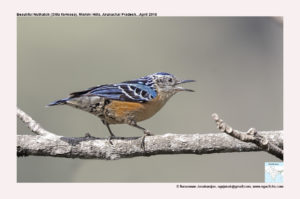
Beautiful Nuthatch Sitta formosa.
Etymology:
- Sitta : Greek word for a bird like a woodpecker
- Formosa : Latin word for Beautiful
Distribution in India: Resident of Eastern Himalayas and North East hills in India.
Description: Size of 12·5–14 cm, wt. of 16·5 cm. It is a large nuthatch with highly distinctive plumage coloration and pattern. It is black from forehead to mantle, feathers of forehead are finely tipped off-white and those of crown to upper mantle tipped lilac-white to cornflower-blue, forming streaks. The lores and supercilium are off-white, variably washed cinnamon-orange and with some black streaking, irregular dark eyestripe behind eye. The scapulars and back to uppertail-coverts are sky-blue, longest uppertail-coverts tipped white, black centers and grey bases of feathers sometimes visible. The lesser upperwing-coverts are blue, median coverts are black with grey base and white, greater coverts are black with grey-blue base and white tip and with very fine blue fringe, alula and primary coverts are black, latter fringed violet-blue. The flight-feathers are black, tertials are broadly fringed and tipped dull grey-blue, extreme fringe on inner two tertials are white. The secondaries are fringed sky-blue; primaries are fringed violet-blue .The central tail feathers are grey-washed sky-blue with black central stripe not reaching tip, other rectrices are black, tipped grey-blue and fringed blue, tips becoming broader but fringes reduced towards outer tail feathers ,outer three feather pairs with white subterminal spot on inner web. The chin, throat and ear-coverts are off-white, side of neck and underparts are cinnamon-orange, deepest on vent and flanks, paler and buffer on undertail-coverts, thighs are sooty brown; axillaries are dark grey, narrowly fringed grey-buff, underwing-coverts are black, contrasting diagonal white stripe at base of primaries. The iris is reddish-brown to dark brown; bill is black, whitish at base of lower mandible, legs are yellowish-brown, olive-brown or greenish-horn. Both the sexes are alike. Juvenile resembles adult, but face and lores blacker, crown and upper mantle more densely spotted turquoise-blue, and underparts, especially breast paler and whiter.
Habitat: It can be found in mature subtropical broadleaf forest with large, spreading epiphyte-laden trees and open country with scattered trees. Found from 300 m to 2300 m
Food habits: It eats insects. It is found singly, in pairs and often associated with mixed-species foraging flocks. It usually forages unhurriedly in middle and upper canopies of tall trees; works through a few trees and then often flies considerable distance to others. It looks for mosses, lichens, orchids and other epiphytes; also gleans items from trunks and branches, with preference for larger branches.
Breeding habits: They breed in Apr–Jun in North East India. The nest is made of leaves and bark chips, lined with pad of fur, especially that of bamboo rat, placed in hole above ground in tree, entrance hole reduced with clay “masonry”. They lay a clutch of 4–6 eggs.